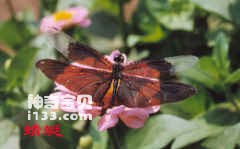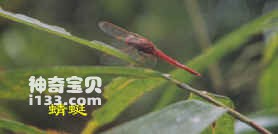[Economic Significance] Dragonflies have slender bodies, bright colors, elegant postures, flexible and agile flight, interesting and attractive. They are people's favorite ornamental insects, often active in fields, gardens and other places during the day. The idiom "dragonfly touches the water" quoted by people actually refers to the phenomenon of female insects laying eggs after mating. Every time they touch the water surface, one egg is laid, and the action is very fast. People use this idiom to describe the meaning of work that is not in-depth. Both adults and larvae are predatory and are often regarded as beneficial insects in agriculture and health. However, adults attack bee colonies and larvae attack fry or small fish.

[Identification points]: Most dragonflies are 30-90 mm in length, a few species can reach 150 mm, and some species are very slender, less than 20 mm in length. The head is large, the compound eyes are large and protruding; the antennae are bristly, and the mouthparts are chewing. The chest is well developed and firm. The front and rear wings are equal in length and narrow, with reticular veins, obvious wing nevus and wing knots. They are stretched flat, or erect, or erected diagonally on the back when resting. Feet have many stinging hairs. The tail is small, 1 section. The larvae are aquatic, and their lower lip is specially designed as a mask, and they breathe through the rectum or tail gills.
The male dragonfly's copulatory organ is located on the ventral surface of the second abdominal segment, which is unique among insects, but its genital pore is still on the ninth abdominal segment. Before mating, the male first sends semen from the genital pore to the second abdominal segment for mating. inside the device. During mating, the male uses the gripper at the end of the abdomen to hold the female's chest, and then the female bends her abdomen forward to connect her genital pore with the male's copulatory organ. The entire process can be performed on the fly. The phenomenon when people see two dragonflies flying next to each other is part of the mating process.

[Species and Distribution] About 5,000 species are known in the world, and more than 400 species have been recorded in my country. Widely distributed globally. There are two main suborders, (1) Homoptera (suborder Damselflies): The body is slender, the shape of the two pairs of wings is very similar, and the four wings stand upright on the back when resting. (2) Parapterygoid suborder (Odonata): The body is stout, the base of the hind wings is wider than the forewings, and the two pairs of wings are stretched flat when resting.
The characteristics of this order can be summarized as follows: flying dragons are insect-catching dragonflies, with bristly antennae and spiny legs; four well-developed wings with knotted nevus, short and thick tail whiskers and a long and slender abdomen.
animal tags: Odonata dragonflies
We created this article in conjunction with AI technology, then made sure it was fact-checked and edited by a Animals Top editor.